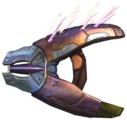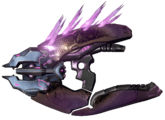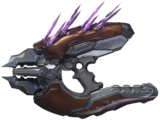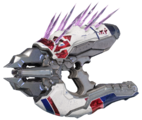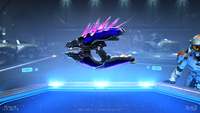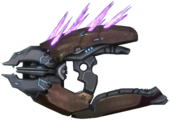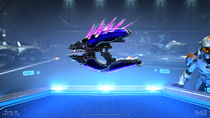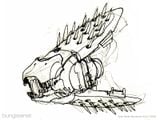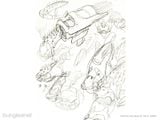User:JackVibe/Sandbox
From Halopedia, the Halo wiki
| Needler | |
|---|---|
 One pattern of the Needler, most commonly referred to as a Type-33 needler. | |
| Weapon information | |
|
Type: |
|
|
Series: |
Needler[2] |
|
Description: |
Subanese crystal projectile weapon[2] |
| Production information | |
|
Manufacturer: |
|
|
Model(s): |
|
- "Luckily—listen to me "luckily"—the needles only detonate when they’re embedded in living tissue. Now that’s lucky because it’s not gonna blow a hole in the wall you’re hiding behind or tear the tires off of the vehicle you’re trying to escape in."
- — Anonymous UNSC E2-BAG/1/7 serviceman[5]
Needlers, and sometimes known as the Needler pistols,[6] are a class of single-handed, fully-automatic infantry specialized weapons developed by the Covenant that launch chemically-charged Subanese crystalline shards with the ability to track targets.[7] The Covenant and its remnants formally designated the needler as needle launcher or shard launcher,[8][9] while the Office of Naval Intelligence has typically type-classified encountered needlers variants under the designation of the Type-33 Guided Munitions Launcher (T-33 GML) or Type-56 Guided Munitions Launcher (T-56 GML).
Overview
Design details
- "Anything stuck with enough needles will blow sky high—and if a Foxtrot is unlucky enough to be carrying grenades, those are gonna cook off too."
- — Anonymous UNSC E2-BAG/1/7 serviceman[5]
While there are multiple known patterns of the needler, all needler patterns share the same general design which revolves around its function of firing individual, crystalline shards.[10] The top of the weapon contains needler's distinctive ammunition, Subanese crystals, with the exposed needles protruding from holes in the weapon chassis. The bottom of the weapon, which contains the power supply, doubles as a stock,[7] with an extended handguard on some variants.[10] The two main components converge at the muzzle in front of the grip. The barrel is situated between an upper and a lower channel braces; the channel braces extend outward around the muzzle, presumably to prevent the barrel from being blocked.[7]
Ammunition
- Main article: Subanese crystal
- "I caught three in the leg as I was diving behind a broken wall—they lodged right in there where the greave meets the boot. When they went off, it damn near broke my ankle and flung like little splinters of glass or crystal or whatever all up my left side—the corpsman was pulling [the shards] outta me for the better part of two hours."
- — Anonymous UNSC E2-BAG/1/7 serviceman[5]
The needler fires shards of Subanese crystal—sometimes known as Blamite—a pink crystalline substance mined from Suban, one of Sangheilios' two moons.[10][8][7] The exposed crystals are held on the upper cowling of the weapon,[10][7] allowing the user to use the exposed shards as an improvised melee weapon.[11][12]
Upon impaling a target, the crystalline shards become chemically reactive, and detonate after a few seconds.[10][9] Injuries inflicted from the exploding shard are gruesome, as microscopic pieces of shrapnel can become embedded in tissue.[5] If multiple shards embed within a living target, then a chain reaction occurs—their chemical properties "supercombine" and the shards detonate simultaneously through proximal resonance instability,[7] causing an immediate and violent explosion.[10][9] While the shards are devastating against living tissue, they are relatively ineffective against energy shielding.[13] Certain variants of the weapon fire calibrated crystalline shards that can embed in armor.[14]
Operation
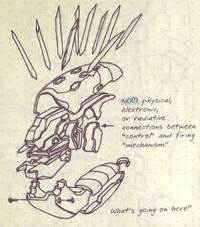
- Main article: Needle-based weaponry
- "I don't know how it works, but it seems the needles can only follow you if they can "see" you."
- — Anonymous UNSC E2-BAG/1/7 serviceman[5]
As with all Covenant needle-based weaponry, the needler's inner mechanism break the crystals into needle-like shards, then launch the shards from the weapon.[8] When the trigger is pulled, the needle is fed from the top into the "barrel" and fired at high speed. The needler notably features an additional magnetic auger within the weapon that catalyzes the shards by charging their chemical mixture,[10] which then become capable of tracking specific heat signatures of sighted targets.[15]
While it is believed that the Covenant had likely reverse-engineered the Forerunner shard cannon to create their needle-based weaponry,[16] the needler is considered unique among Covenant weapons in that it does not require Forerunner technology to function.[17] The needler was one of the most unusual weapons in the Covenant arsenal and the least understood; by 2552, how the weapon functions still remains a mystery to human military experts and scientists, despite the weapon being encountered early on during the war. Like most Covenant weapons, the needler lacks any kind of electronic, physical, or radiative connections between its trigger and firing mechanism.[18] The physics behind the weapon were apparently not well known as joint human and Sangheili teams were known to be studying the weapon some time after the war.[19]
Development history
- "It's about as close to a fire-and-forget small arm that we're likely to ever see—and it ain't ours. This is why we're losing."
- — Anonymous UNSC E2-BAG/1/7 serviceman[5]
Prior to the Covenant's formation, the Sangheili mined Subanese Crystals, using it in unique ways.[17]
Prior to 2552, the needler was manufactured by the Sacred Promissory on High Charity.[2] After the fall of High Charity during the Great Schism, the manufacturing of the needler fell to Lodam Armory.[3]
Usage
- "First order of business when dealing with a hostile armed with a Needler is finding cover; second order of business is killing the Mike Foxtrot with the Needler."
- — Anonymous UNSC E2-BAG/1/7 serviceman[5]
Within the Covenant and its splinter factions, the needler was favored for its mechanical simplicity and, more importantly, the potential to inflict gruesome damage with negligible accuracy through a combination of the shards' tracking ability and the "supercombine" explosion resulting from multiple shards being embedded within a target.[8][17] As such, the needler was a common sight among the lower caste,[8] like the Unggoy, Kig-Yar, and Yanme'e,[20] as well as poorly-train soldiers,[17] like Minors across different species.[20][21] However, the needler is also considered a specialist weapon;[8] subsequently, it also saw widespread usage among specialist troops like the Storm shock troops,[22] Stealth Sangheili,[23] and Special Operations Unggoy.[24] Larger variants of the needler, the needle cannon, are mounted as anti-air weaponry on both vehicles and weapon emplacements, like the Bkowe'nei-pattern Vampire and the Kewu Umppi'pa'-pattern citadel turret.[25][26][27]
A diverse range of needlers have been used throughout the Human-Covenant War, and the UNSC has catalogued multiple patterns of needlers as the Type-33 needler as early as 2533.[10] The needler was one of the many Covenant weapons featured in Doctor Robert McLees' Machines, Materiel and Munitions from the Human-Covenant Conflict, 2525 - Present.[5]
Following the Great Schism and the dissolution of the Covenant, needlers were inherited by various its splinter factions, and even found appeal among human pirates who considered the weapon flashy and intimidating.[8] New patterns of the needler, like those fielded by Jul 'Mdama's Covenant, were catalogued by the UNSC in 2556 under the Type-56 designation.[4] The Banished also quickly adopted the needler; while Banished warsmiths were unknowledgeable of the weapon's mechanisms, the needler's gruesome and simple design meant there was no immediate desire to alter or improve its design.[9] The Posu'gelka-pattern needler notably saw use during the Battle for Zeta Halo,[9] primarily fielded by Unggoy Conscripts and Ultras, Kig-Yar Freebooters, and Skirmishers.[28]
Special Operations Unggoy were typically armed with Needlers to combat the Flood.
Types
Type-33 needler
- Main article: Type-33 needler
The "Type-33 Guided Munitions Launcher", also known as the "Type-33 needler", is a human term for a group of needlers that were seen across the Human-Covenant War.[29][30][31][2]
Type-33 needler[2]
Type-56 needler
The "Type-56 needler" is a human term for a group of needlers that were started to be recorded in 2556.[4]
- Type-56D needler: This is a version of the needler that features a holographic Smart scope projector on its barrel.[32]
Posu'gelka-pattern needler
- Main article: Posu'gelka-pattern needler
This variant of needler has an ammo counter on the chassis. This variant was employed by the Banished during the Battle for Installation 07 in 2560.[28]
Related arsenal
Weaponry
Vehicles
Aerial vehicles
In-game information
The Needler has appeared in several games in the Halo franchise.
Type-33 needler
Halo: Combat Evolved[2]Type-33 needler
Halo 2Type-33 needler
Halo 3 and Halo 3: ODSTType-33 needler
Halo Reach and Halo 4Type-56D needler
Halo 5: GuardiansPosu'gelka-pattern needler
Halo Infinite
Gallery

|
Browse more images in this article's gallery page. |
Concept art
List of appearances
Sources
- ^ Halo: The Essential Visual Guide - Needle Rifle, page 127
- ^ a b c d e f g h Halo: The Essential Visual Guide - Needler, page 128
- ^ a b Halo 4: The Essential Visual Guide - Weapons, Needler, page 85
- ^ a b c Halo Waypoint - News, Canon Fodder, Locke & Load (Retrieved on Aug 2, 2021) [local archive] [external archive]
- ^ a b c d e f g h Bungie.net, Type-33 Guided Munitions Launcher - 9/6/2007 (Retrieved on Jan 16, 2021) [archive]
- ^ Halo: Ghosts of Onyx, chapter 22
- ^ a b c d e f Halo 4: The Essential Visual Guide, page 85
- ^ a b c d e f g Halo Encyclopedia (2022 edition), page 294
- ^ a b c d e Halo Encyclopedia (2022 edition), page 479
- ^ a b c d e f g h Halo: The Essential Visual Guide, page 128
- ^ Halo: Combat Evolved, Needler melee animation
- ^ Halo Infinite, Needler melee animation
- ^ Halo Waypoint, Universe - Weapons - Needler (Retrieved on Apr 21, 2021) [archive]
- ^ a b Halo 5: Guardians, Talon of the Lost: "Sangheili miners and engineers continue to discover amazing new properties of the Subanese crystals used in Needler ammunition. Advanced Needler that fires carefully calibrated shards that can embed themselves in armor."
- ^ Halo Waypoint, Halo 4 Interactive Guide - Covenant Weapons (Retrieved on Mar 27, 2014) [local archive] [external archive]
- ^ Halo Encyclopedia (2011 edition), page 237
- ^ a b c d Halo Waypoint - Universe - Weapons, Needler (Retrieved on Aug 2, 2021) [local archive] [external archive]
- ^ Halo: Reach, Dr. Halsey's personal journal
- ^ Halo Waypoint, Forums - Catalog Interaction (post 2969311) (Retrieved on Oct 14, 2014) [local archive] [external archive]
- ^ a b Halo: Reach, gameplay
- ^ Halo 3: ODST, gameplay
- ^ Halo 4, gameplay
- ^ Halo Wars, campaign level Relic Interior
- ^ Halo: Combat Evolved, campaign level The Maw
- ^ Halo Wars, gameplay
- ^ Halo Encyclopedia (2022 edition), page 200
- ^ Halo Encyclopedia (2022 edition), page 301
- ^ a b Halo Infinite, gameplay
- ^ Halo 2, Needler
- ^ Halo 3, Needler
- ^ Halo: Reach, Needler
- ^ Halo 5: Guardians, Needler
- ^ Halo 5: Guardians, Needler: Hailstorm
| |||||||||||
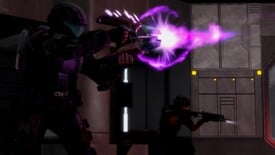


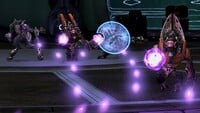


![Type-33 needler[2]](https://halo.wiki.gallery/images/thumb/6/6f/Needler-HaloCE.png/134px-Needler-HaloCE.png)
